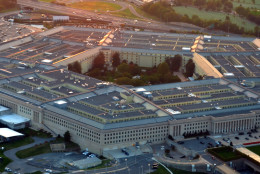DoD Reporter's Notebook
-
In its annual assessment of DoD’s major weapons systems, GAO calculated that over the past year, the department has seen a $10.7 billion increase in its “buying power."
April 03, 2017 -
The Pentagon met the letter of the law by turning in a report to Congress on how it plans to implement one of its largest organizational changes in decades.
March 07, 2017 -
The Defense Science Board's latest study on the state of cyber defense in the U.S. reached some worrying conclusions, both for civil infrastructure and for military capability.
March 07, 2017 -
Almost exactly four years after the Defense and Veterans Affairs departments decided to go their separate ways in their projects to modernize their electronic health records, DoD’s brand new EHR is now up and running, at least at one base.
February 14, 2017 -
When it comes to defending the country from cyber attack, Defense officials have made abundantly clear that they plan to leverage the military’s National Guard and reserve components as much as possible, including, most recently, by tasking the Army Guard and Reserve to build 21 cyber teams on top of the 133 U.S. Cyber Command had planned as part of its Cyber Mission Force.
February 14, 2017 -
Retired Marine Gen. James Mattis is the only member of the Trump administration's Defense team to be nominated, yet alone undergo a confirmation hearing.
January 24, 2017 -
When Army officials decided to launch the service’s first-ever bug bounty, one of the key questions they wanted to answer was whether sensitive personnel records were vulnerable to theft by hackers via the Army’s public-facing websites. As it turns out, the answer was yes.
January 24, 2017 -
Army Secretary Eric Fanning has issued highly detailed orders to three-and-four star generals in the Army's headquarters and functional and geographic commands, telling them precisely what must be done to close 60 percent of the service’s 1,200 data centers by the end of 2018 and 75 percent by 2025.
January 10, 2017 -
The Pentagon is developing a new web portal to make it easier for firms to let the government know about their independent research & development (IR&D) activities.
January 10, 2017 -
The Air Force is standing up a new, full-time office dedicated to protecting its weapons systems from cyber attacks.
January 10, 2017 -
The 2016 update to the Navy Force Structure Assessment, sent to Congress last week, asserts the service needs a fleet of 355 ships in order to adequately perform its missions. That’s a big change from the 2014 plan of 308 ships the Navy has been building toward.
December 19, 2016 -
The Army says it’s becoming the first of the military services to launch a digital service “outpost” and wants a dedicated team of technology experts from outside the government to tackle its own problems.
December 19, 2016 -
The federal government decided to put the Defense Department in charge of building a new information technology backbone to house and process all of the data involved in security clearance investigations, one that would be safer from foreign attacks.
December 19, 2016 -
Advocates and defenders of the federal bid protest process received some welcome news last week as part of the House-Senate agreement on this year’s National Defense Authorization Act. The final deal stripped two key Senate provisions that were seen as hostile to the protest process.
December 05, 2016 -
Besides restructuring and bifurcating the large front office that’s currently responsible for both acquisition and R&D, the bill adds several new authorities that build on last year’s trend of letting DoD sidestep the traditional acquisition system.
December 05, 2016














